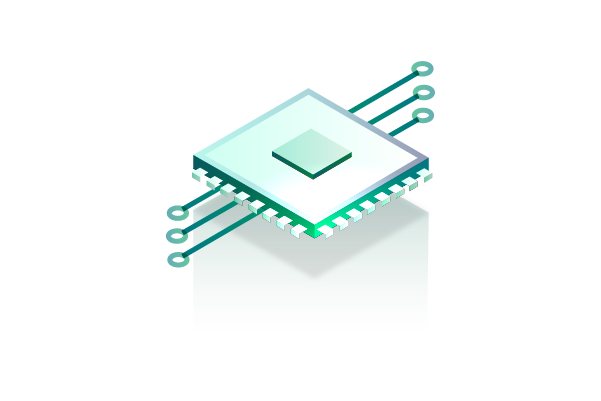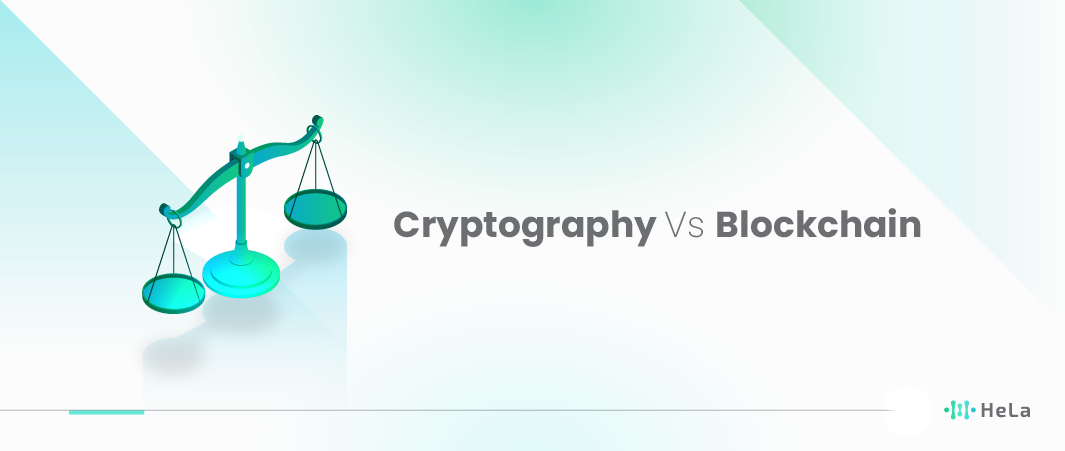The digital world has rapidly evolved into a complex network where data security and decentralized systems are crucial. In this context, cryptography and blockchain stand out as key technologies reshaping data protection and system architecture. This discussion aims to explore these technologies, highlighting their importance and distinct roles in the modern digital landscape.
Cryptography is the digital art of secrecy, vital for secure communication. It involves complex algorithms to encode information, ensuring confidentiality and integrity in digital interactions. This section simplifies cryptography, presenting its principles in an accessible manner, emphasizing its role as a cornerstone of digital security.
Blockchain, often linked with cryptocurrencies, is a revolutionary technology with broader implications. It’s a series of digital records, each cryptographically linked to the previous, ensuring transparency and security. Beyond digital currencies, blockchain’s potential is vast, offering transformative solutions in various sectors. Here, we unpack the structure of blockchain and its expansive potential beyond its initial cryptocurrency applications.
The Fundamentals of Cryptography
Cryptography, a discipline with ancient roots, has evolved significantly over centuries, transforming from simple message concealment methods to complex algorithms that secure modern digital communication. At its core, cryptography aims to protect information by transforming it into an unreadable format, a process known as encryption, and then reverting it back to a readable format, known as decryption, when needed.
Origins and Evolution of Cryptography
The origins of cryptography can be traced back to ancient civilizations. The ancient Egyptians, Greeks, and Romans employed basic cryptographic techniques to communicate secretly in military, political, and diplomatic affairs. One of the earliest known uses of cryptography was the Caesar cipher, a substitution cipher used by Julius Caesar to protect messages of military significance.
Over time, as mathematics and technology progressed, so did cryptographic methods. The 20th century, particularly during World Wars I and II, saw significant advancements. The Enigma machine, used by the Germans in WWII, and the efforts of the Allied codebreakers, are testament to the crucial role of cryptography in modern history.
Fundamental Mechanisms: Encryption and Decryption

Encryption is the process of converting plaintext into ciphertext, a non-readable form, using an algorithm and a key. Decryption is the reverse process, turning ciphertext back into readable plain text using the same (symmetric encryption) or a different (asymmetric encryption) key. The strength of encryption lies in the complexity of the algorithm and the secrecy of the key.
Common Cryptographic Methods
- Symmetric Encryption: In symmetric encryption, the same key is used for both encryption and decryption. It’s fast and efficient, ideal for encrypting large volumes of data. Examples include the Advanced Encryption Standard (AES) and Data Encryption Standard (DES).
- Asymmetric Encryption: Asymmetric encryption, or public key cryptography, uses a pair of keys: a public key for encryption and a private key for decryption. It’s fundamental for secure communication over insecure channels and is the backbone of technologies like SSL/TLS. RSA and Elliptic Curve Cryptography (ECC) are well-known asymmetric algorithms.
- Hashing: Hashing is the process of converting input data into a fixed-size string of characters, which appears random. It is used to verify data integrity and is a cornerstone of modern password storage and verification. Algorithms like SHA-256 are commonly used for hashing.
- Digital Signatures: Digital signatures provide a means to verify the authenticity and integrity of a message or document. They use asymmetric encryption to create a signature that is unique to both the document and the signer’s private key, ensuring that a document has not been tampered with and confirming the identity of the signer.
Cryptography’s journey from ancient scripts to digital encryption illustrates its indispensable role in securing information. Its mechanisms, whether through symmetric/asymmetric encryption, hashing, or digital signatures, form the backbone of digital security, safeguarding data integrity, confidentiality, and authenticity in our increasingly digital world.
Understanding Blockchain Technology
Blockchain technology is fundamentally a distributed ledger system that is acclaimed for its robust security and transparency. It’s akin to a continuously expanding chain of records, termed “blocks,” securely linked together using cryptography. Below is an in-depth exploration of the basic structure, components, and operation of a blockchain, along with its distinctive features:
Basic Structure of a Blockchain
- Blocks: Each block in a blockchain contains a collection of data. This data varies depending on the blockchain. For instance, a block on the Bitcoin blockchain stores information about transactions.
- Chain: The blocks are chained together in a sequential manner. Each block contains a unique code called a hash, which changes if the information inside the block is tampered with. This makes blockchains secure.
Also Read: What Is BscScan? Features, Functions, and Insights
Components of a Blockchain
- Blocks: As mentioned, these are individual records. Each block contains transaction data, the hash of the block, and the hash of the previous block, which creates the link in the chain.
- Nodes: These are individual computers that connect to the blockchain network. Each node has a copy of the entire blockchain and works to maintain its integrity and transparency.
- Miners: Miners are specific nodes that perform the computational work needed to add new blocks to the chain. This process is known as mining.
Operation of a Blockchain
- Creation of Blocks: When a block’s data capacity is reached, it’s closed and linked to the chain. Then, a new block is formed, containing a reference to the hash of the previous block, thus creating the chain of blocks.
- Consensus Mechanisms: These are protocols that ensure all nodes are synchronized with the blockchain. They prevent fraud and ensure that all participants agree on the true state of the blockchain ledger. Examples include Proof of Work (used by Bitcoin) and Proof of Stake.
Distinctive Features of Blockchain
- Immutability: Once data has been written to a blockchain, it is nearly impossible to change or delete it. This is due to the cryptographic hash links between blocks. Changing data in a previous block would require altering all subsequent blocks, which is computationally impractical.
- Transparency: Transaction histories are becoming more transparent through the use of blockchain. Because of its distributed ledger, all network participants share the same documentation as opposed to individual copies. This shared version can only be updated through consensus, meaning everyone must agree on it.
- Decentralization: Unlike traditional systems where a central entity controls the data, blockchain technology allows data to be stored on thousands of servers across the globe. Every node in the network has a copy of the ledger, reducing the risk of centralized data breaches and control.
Understanding these core aspects of blockchain technology elucidates why it’s regarded as a revolutionary approach to data security and transparency in the digital age. Its applications extend beyond cryptocurrency, promising innovations in various sectors like supply chain management, healthcare, and more.
Cryptography in Blockchain: The Binding Force

Cryptography serves as the cornerstone of blockchain technology, ensuring its integrity, security, and trustworthiness. It is the binding force that enables the decentralized and secure nature of the blockchain. Here’s how cryptography plays an integral role in the functioning of blockchain:
Hash Functions: Ensuring Data Integrity and Structure
- Data Immutability: Hash functions convert input data of any size into a fixed-size string of characters, which represents the data uniquely. Any alteration in the input data, even a minor one, results in a completely different hash. This property is crucial for maintaining the integrity of the blockchain. Each block contains the hash of the previous block, creating a linked chain. If any data in a block is altered, the hash changes, invalidating all subsequent blocks, which helps in detecting and preventing tampering.
- Efficient Data Structure: Blockchains utilize hash functions to structure data efficiently. For instance, Bitcoin uses a structure called the Merkle Tree, which aggregates multiple transaction hashes into a single hash, representing the entire set of transactions in a block. This structure allows for quick and secure verification of transaction data.
Proof of Work: Maintaining Network Consensus and Security
- Consensus Mechanism: Proof of Work (PoW) is a consensus mechanism that requires participants (miners) to solve complex mathematical problems to validate transactions and create new blocks. The process is computationally intensive and serves as a deterrent against spam and fraudulent activities.
- Network Security: By requiring significant computational effort, PoW ensures that no single entity can control the majority of the computational power of the network. This makes it economically unfeasible to manipulate the blockchain, as the cost of obtaining the necessary computational power would exceed the rewards.
Public-Private Key Encryption: Ensuring Confidentiality and Authenticity
- Ownership and Authorization: Public-private key pairs are cryptographic keys that enable secure communication on the blockchain. A user’s public key is openly shared and used to generate a blockchain address, while the private key remains confidential. Owning a private key is akin to having ownership rights over the corresponding blockchain assets.
- Digital Signatures: Transactions are signed with the sender’s private key and can be verified by others using the corresponding public key. This ensures the authenticity of the transaction, as only the owner of the private key could have created the signature. It also ensures non-repudiation, meaning the sender cannot deny having sent the transaction.
Cryptography not only ensures the security and integrity of the blockchain but also facilitates the creation of a trustless environment. Users do not need to trust each other or a central authority; instead, they rely on the cryptographic principles underpinning the blockchain to ensure that the system is secure, immutable, and transparent.
Applications and Impact of Cryptography and Blockchain
Cryptography and blockchain are two distinct yet interconnected technologies that have reshaped various sectors through their unique applications and impacts.
Cryptography
- Secure Communications: Cryptography is fundamental to secure communication channels over the internet. Techniques like encryption ensure that messages or information are accessible only to the intended recipients. SSL/TLS protocols used in securing web communications are prime examples of cryptography in action.
- Digital Signatures: Digital signatures use cryptographic algorithms to authenticate the identity of the sender and ensure the integrity of the message or document. This application is crucial in legal, financial, and governmental digital documents, ensuring trust and non-repudiation.
- Cybersecurity: Cryptography forms the backbone of modern cybersecurity defenses, protecting data from unauthorized access and breaches. Encryption algorithms safeguard sensitive data both at rest and in transit, playing a critical role in data protection standards like GDPR and HIPAA.
Blockchain
- Finance – Cryptocurrencies: Blockchain technology is perhaps best known for its application in cryptocurrencies like Bitcoin and Ethereum. It provides a decentralized ledger that records all transactions securely and transparently, eliminating the need for a central authority and reducing the risk of fraud.
- Supply Chain Management: Blockchain enhances transparency and traceability in supply chains. It allows all parties to track assets from production to delivery, ensuring authenticity and reducing the chances of counterfeit products.
- Voting Systems: Blockchain can revolutionize voting systems by providing a secure, transparent, and immutable voting mechanism. This can increase trust in the electoral process, reduce the risk of fraud, and ensure that each vote is counted accurately.
Comparative Analysis
While both cryptography and blockchain offer robust security features, their applications and impacts vary significantly:
Scope of Application
- Cryptography is a fundamental technology that underpins various aspects of digital security, from encrypting messages to securing online transactions.
- Blockchain, while utilizing cryptographic principles for security, mainly revolutionizes how data is structured and shared across decentralized networks, focusing on transparency, immutability, and distribution of control.
Trust and Control
- Cryptography enables trust by ensuring the confidentiality, integrity, and authenticity of data and communications.
- Blockchain redefines trust in transactions and interactions by creating a decentralized and immutable ledger, removing the need for a central authoritative entity and reducing single points of failure.
Industry Impact
- Cryptography is industry-agnostic and finds applications across various sectors wherever data security is a priority.
- Blockchain has found significant applications in specific industries like finance (with cryptocurrencies and smart contracts) and supply chain management but is expanding its reach as the technology matures.
While cryptography focuses on securing data and communications through encryption and related techniques, blockchain leverages these cryptographic principles to offer a new paradigm for transactional data and asset management across decentralized networks. Both technologies complement each other and, when combined, can offer robust solutions for secure, transparent, and efficient digital interactions and transactions across various sectors.
Challenges and Future Potential

Both quantum computing and blockchain technology are at the forefront of innovation, offering groundbreaking opportunities across various sectors. However, they each come with their own set of challenges. When discussing these technologies, it’s essential to consider not only their current limitations but also the potential future developments that could address these challenges.
Quantum Computing Challenges
- Decoherence and Quantum Error Correction: Quantum systems are extremely sensitive to external disturbances, leading to decoherence. This makes maintaining the stability of qubits over time a significant challenge. Additionally, the quantum error correction methods needed to address this are complex and resource-intensive.
- Resource Requirements: Building and maintaining quantum computers require highly specialized environments. They need to operate at incredibly low temperatures and are sensitive to even the slightest environmental changes.
- Threats to Cryptography: Quantum computing poses a significant threat to current cryptographic systems. Algorithms like RSA and ECC, which secure much of today’s digital communication, could potentially be broken by a sufficiently powerful quantum computer.
Future Potential
- Advancements in Quantum Error Correction: Research is ongoing to develop more efficient quantum error correction techniques, potentially making quantum computers more stable and reliable.
- Hybrid Quantum-Classical Systems: Leveraging the strengths of both quantum and classical systems could address current resource and stability issues, paving the way for more practical and scalable quantum computing solutions.
- Post-Quantum Cryptography: The development of new cryptographic algorithms that are secure against quantum attacks is a priority. This field, known as post-quantum cryptography, is likely to grow in importance as quantum computing becomes more prevalent.
Also Read: What Is Multichain Wallet? Benefits and Development
Blockchain Technology Challenges
- Scalability: Current blockchain implementations, like Bitcoin and Ethereum, face significant challenges regarding transaction speed and volume. The decentralized nature of blockchains can lead to inefficiencies and high energy consumption.
- Security Concerns: While blockchains are generally secure, they are not immune to attacks. Issues like 51% attacks, where an entity gains control of the majority of a network’s hashing power, can compromise security.
- Regulatory and Legal Hurdles: The decentralized and often anonymous nature of blockchain can clash with existing regulatory frameworks, leading to potential legal challenges and uncertainty.
Future Potential
- Layer 2 Solutions & New Consensus Mechanisms: Technologies like Lightning Network for Bitcoin or sharding in Ethereum 2.0 aim to address the scalability issue. New consensus mechanisms, like Proof of Stake (PoS), are also being developed to reduce energy consumption and increase transaction speeds.
- Enhanced Security Protocols: As the technology matures, we can expect more sophisticated security measures to emerge, further safeguarding blockchain against attacks.
- Integration with Traditional Systems: Efforts are being made to make blockchain more compatible with existing legal and regulatory frameworks. This could lead to wider adoption and integration with traditional financial systems.
Both quantum computing and blockchain technology are in their nascent stages, facing significant challenges but also holding immense potential. The future will likely see these technologies becoming more integrated into mainstream applications, addressing their current limitations and unlocking new possibilities across various industries. As they evolve, it’s crucial to monitor these developments and prepare for the transformative impact they could have on the digital landscape.
Conclusion
In the intricate tapestry of modern technology, cryptography and blockchain emerge as pivotal threads, each playing a unique and vital role. Cryptography, with its complex algorithms and encryption techniques, acts as the bedrock of security, ensuring the confidentiality, integrity, and authenticity of digital information. Blockchain, on the other hand, thrives as a revolutionary ledger technology, fostering trust and transparency in decentralized systems. The amalgamation of these technologies marks a significant stride in the digital era, fortifying data security and enabling a plethora of innovative applications across various sectors.
The synergy between cryptography and blockchain is not merely coincidental but fundamentally transformative. Cryptography is the silent sentinel guarding the gates of blockchain, ensuring that each transaction is securely encrypted and immutable. This symbiotic relationship enhances the robustness of digital solutions, cultivating an environment where transactions are not only transparent but also secure from tampering and fraud. As blockchain technology evolves, it further leverages cryptographic advancements, driving the development of more sophisticated and secure digital ecosystems.
Looking ahead, the horizon is ripe with potential for both cryptography and blockchain. The continuous evolution in cryptographic techniques is anticipated to bolster blockchain’s resilience, paving the way for more secure and efficient solutions. Innovations such as quantum-resistant cryptography and more scalable blockchain frameworks are on the cusp of reshaping the digital landscape. As these technologies advance hand in hand, they hold the promise of addressing the multifaceted challenges of the future digital world, ensuring that security, privacy, and efficiency are not just aspirations but tangible realities in the ever-evolving digital age.

I am Carina Caringal, a technical writer specializing in blockchain engineering concepts, decentralized systems, crypto infrastructure, and Web3 technologies. My work focuses on analyzing and translating complex technical mechanisms into precise, structured, and insightful content for both developers and non-technical readers who want a deeper understanding of the decentralized ecosystem.
My background in blockchain and cryptocurrency is rooted in years of independent research, continuous learning, and hands-on exploration across multiple protocols and network architectures. I study the underlying mechanics of distributed ledger technology, from consensus algorithms and smart contract logic to network scalability, security models, cryptographic principles, and interoperability frameworks. This technical foundation shapes the way I approach every article, ensuring accuracy, depth, and relevance.
- Carina Caringalhttps://helalabs.com/blog/author/carina-caringal/
- Carina Caringalhttps://helalabs.com/blog/author/carina-caringal/
- Carina Caringalhttps://helalabs.com/blog/author/carina-caringal/
- Carina Caringalhttps://helalabs.com/blog/author/carina-caringal/

